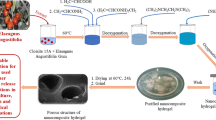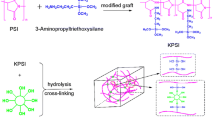Abstract
A pioneer study has been conducted to synthesize novel hydrogel starting from a non-cellulosic raw material, gum dammar-a triterpenoidal system, and then converting this hydrogel into an organic–inorganic composite zirconium-based ion exchanger. Gum dammar was cross-linked with polyacrylamide zirconium (IV) iodo-oxalate [Gd-cl-poly(AAm)-Zr (IV) iodo-oxalate] by incorporating inorganic precipitates into the polymeric mixture. The polymeric mixture was synthesized using gum dammar (Gd), acrylamide (AAm), N, N′-methylene-bis-acrylamide (MBA) and potassium persulphate (KPS). The reaction conditions for synthesis of hydrogel and ion exchanger such as time (120 min), temperature (70 °C), solvent (4 mL), concentration of monomer (12.97 × 10−3 mol/L), initiator (1.48 × 10−4 mol/L), cross-linker (4.22 × 10−4 mol/L) and ratio of zirconium oxychloride (0.1 M), potassium iodate (0.1 M) and oxalic acid (0.1 M) in ratio 2:3:2 were optimized to obtain maximum ion exchange capacity (2.02 meq/g). The morphology and structure of hydrogel and ion exchanger were studied using FTIR, SEM, XRD and TGA/DTA/DTG. The SEM study was followed by energy dispersive spectroscopy for elemental analysis. The ion exchanger was quite stable in various acids and bases at low concentration but it completely dissolved in acids and bases at high concentrations. Distribution studies showed that the synthesized ion exchanger had high selectivity for Pb2+ ions. Thus, the polymeric-inorganic hybrid material showed integration of both inorganic and organic characteristics within the composite material.












Similar content being viewed by others
References
Buchholz FL, Graham AT (1998) Modern superabsorbent polymer technology. Wiley, New York
Hirokawa Y, Tanaka T (1984) Volume phase transition in a nonionic gel. J –Chem Phys 81:6379–6380
Buchholz FL, Graham AT (1997) Modern superabsorbent polymer technology. Elsevier, Amsterdam
Hu Y, Horie K, Tori T, Ushiki H, Tang X (1993) Change in microenvironments in poly (acrylamide) gel with pyrenyl probe due to its volume phase transition induced by pH change. Polym J 25:123–130
Pourjavadi A, Barzegar Sh, Mahdavinia GR (2006) MBA-crosslinked Na-Alg/CMC as a smart full-polysaccharide superabsorbent hydrogels. Carbohydr Polym 66:386–395
Pourjavadi A, Kurdtabar M (2007) Collagen- based highly porous hydrogel without any porogen: synthesis and characteristics. Eur Polym J 43:877–889
Pourjavadi A, Kurdtabar M, Ghasemzadeh H (2008) Salt- and pH-resisting collagen-based highly porous hydrogel. Polym J 40:94–103
Lokhande HT, Varadarajan PV (1992) A new guar gum-based superabsorbent polymer synthesized using gamma radiation as a soil additive. Bioresour Technol 42:119–122
Raju KM, Raju MP, Mohan YM (2003) Synthesis of superabsorbent copolymers as water manageable materials. Polym Int 52:768–772
Guo M, Liu M, Zhan F, Wu L (2005) Preparation and properties of a slow-release membrane-encapsulated urea fertilizer with superabsorbent and moisture preservation. Ind Eng Chem 44:4206–4211
Zhang J, Liu R, Li A, Wang A (2006) Preparation, swelling behaviors and slow-release properties of a poly (acrylic acid-co-acrylamide)/sodium humate superabsorbent composite. Ind Eng Chem Res 45:48–53
Kang GD, Cheon SH, Song SC (2006) Controlled release of doxorubicin from thermosensitive poly (organo phosphazene) hydrogels. Int J Pharm 319:29–36
Kang GD, Cheon SH, Khang G, Song SC (2006) Thermosensitive poly (organophosphazene) hydrogels for a controlled drug delivery. Eur J Pharm Biopharm 63:340–346
Rudzinski WE, Chipuk T, Dave AM, Kumbar SG, Aminabhavi MT (2003) pH- sensitive acrylic-based copolymeric hydrogels for the controlled release of a pesticide and a micronutrient. J Appl Polym Sci 87:394–403
Okieimen FE, Sogbaike CE, Ebhoaye JE (2005) Removal of cadmium and copper ions from aqueous solution with cellulose graft copolymers. Sep Purif Technol 44:85–89
Coppen JJW (1995) Damar’ in gums, resins and latexes of plant origin, non-wood forest products. Rome Food Agric Organ UN 6:65–73
Van Aarssen BG, Cox HC, Hoogendoorn P, De Leeuw JW (1990) A cadinene biopolymer present in fossil and extant dammar resins as a source for cadinanes and bicadinanes in crude oils from Southeast Asia. Geochim Cosmochim Acta 54:3021–3031
Clearfield A (1982) A review of inorganic ion exchange materials: solvent extraction ion exchanger. CRC Press Inc, Boca Raton
Judeinstein P, Sanchez C (1996) Hybrid organic–inorganic materials: a land of multidisciplinary. J Mater Chem 6:511–525
Khan A, Asiri AM, Rub MA, Azum N, Khan AAP, Khan I, Mondal PK (2012) Review on composite cation exchanger as interdisciplinary materials in analytical chemistry. Int J Electrochem Sci 7:3854–3902
Mark JE, Wang S, Ahmad Z (1995) Inorganic-organic composites, including some examples involving polyamides and polyimides. Macormol Symp 98:731–751
Khan AA, Alam MM (2003) Synthesis, characterization and analytical application of new and novel ‘organic–inorganic’ composite material as a cation exchanger and Cd (II) ion selective membrane electrode: polyaniline Sn (IV) tungstoarsenate. React Funct Polym 55:277–290
El-Latif MA, El-Kady MF (2008) Developing and characterization of a new zirconium vanadate ion exchanger and its novel organic–inorganic hybrid. J Appl Polym Sci 4:1–13
Mittal H, Kaith BS, Jindal R (2010) Synthesis, characterization and swelling behavior of poly (acrylamide-co-methacrylic acid) grafted gum ghatti-based superabsorbent hydrogels. Adv Appl Sci Res 1:56–66
Singh P, Rawat JP, Rahman N (2002) Synthesis, characterization and ion exchange properties of a new ion exchange material zirconium (IV) iodooxalate. Indian J Chem A 41:1616–1618
Toppe NE, Pepper KW (1949) Properties of ion-exchange resins in relation to their structure, Part I: titration curves. J Chem Soc 3299–3303. doi:10.1039/JR9490003299
El-Naggar IM, Mowafy EA, Abdel-Galil EA, El-Shahat MF (2010) Synthesis, characterization and ion-exchange properties of a novel ‘organic–inorganic’ hybrid cation-exchanger: polyacrylamide Sn (IV) molybdophosphate. Glob J Phys Chem 1:91–106
Flory PJ (1953) Principles of polymer chemistry, vol 119, issue 3095. Cornell University Press, Ithaca, New York, pp 555–556. doi:10.1126/science.119.3095.555-a
Kaith BS, Jindal R, Sharma R (2015) Synthesis of a gum rosin alcohol-poly(acrylamide) based adsorbent and its application in removal of malachite green dye from waste water. RSC Adv 5:43092–43104
Sharma K, Kaith BS, Kumar V, Kalia S, Kumar V, Swart HC (2014) Synthesis and biodegradation studies of gamma irradiated electrically conductive hydrogels. Polym Degrad Stab 107:166–177
Singh P, Rawat JP, Rahman N (2003) Synthesis and characterization of zirconium (IV) iodovanadate and its use as electron exchanger. Talanta 59:443–452
Pandit B, Chudasama U (2001) Synthesis, characterization and application of an inorgano organic material: p-chlorophenol anchored onto zirconium tungstate. Bull Mater Sci 24:265–271
Chakraborty R, Bhattacharaya K, Chattopadhyay P (2014) Nanostructured zirconium phosphate as ion exchanger: synthesis, size dependent property and analytical application in radiochemical separation. Appl Radiat Isot 85:34–38
Author information
Authors and Affiliations
Corresponding author
Rights and permissions
About this article
Cite this article
Sharma, P., Jindal, R., Maiti, M. et al. Novel organic–inorganic composite material as a cation exchanger from a triterpenoidal system of dammar gum: synthesis, characterization and application. Iran Polym J 25, 671–685 (2016). https://doi.org/10.1007/s13726-016-0456-2
Received:
Accepted:
Published:
Issue Date:
DOI: https://doi.org/10.1007/s13726-016-0456-2




